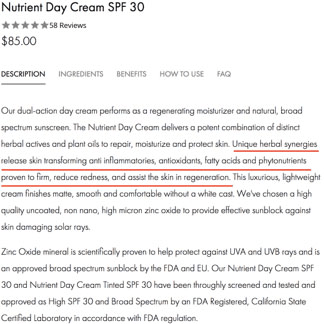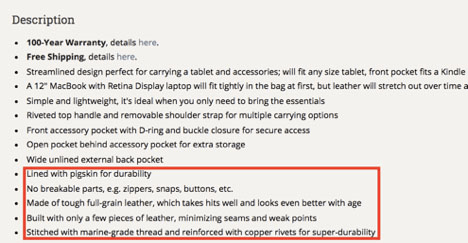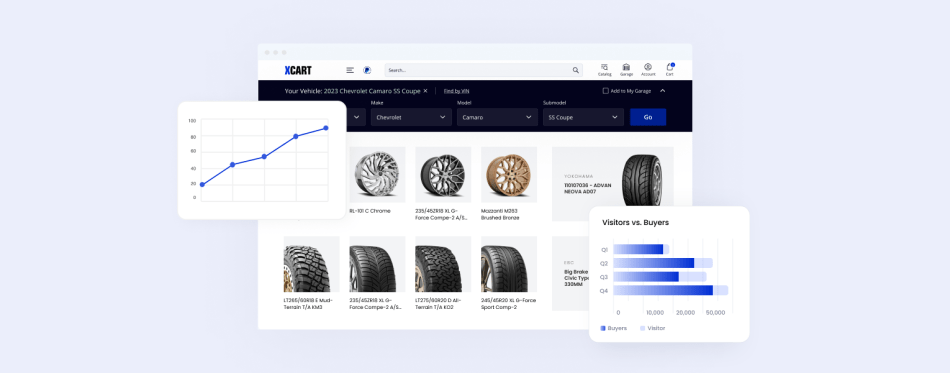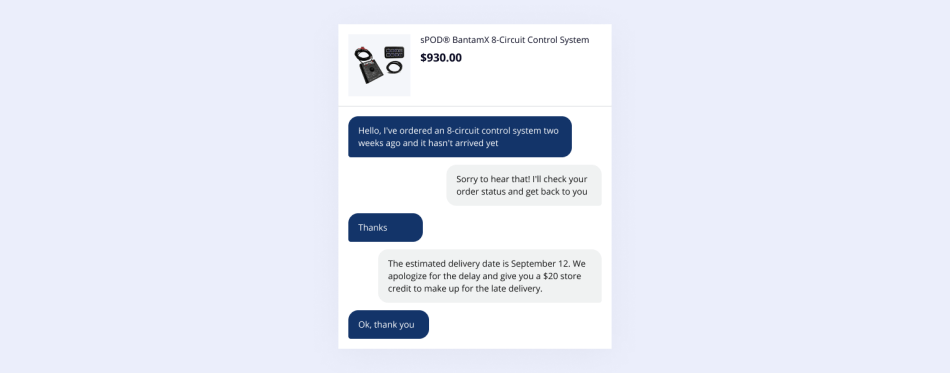How to Write Great Product Descriptions for your Online Store in 8 Steps
This blog post was originally contributed by Reuben Yonatan, the founder of GetVoIP.
How do you write product descriptions that convince sellers to buy without being too salesy? It’s an age-old question.
Seductive product descriptions can mean moving units or watching your inventory decompose. Potential customers make purchase decisions after reading your product description, you have some work to do. Here are 8 crucial ingredients for eCommerce store product descriptions that sell.
1. Base your product descriptions on your target audience
Before selling online, you must learn your customers. One of the most effective ways to improve your product descriptions is to gear them towards individual buyer personas. An ideal buyer persona quantifies the behaviors of your customers, giving you more opportunity to compose effective product descriptions.
For example, knowing that previous customers enjoy your products because of their durability may encourage you to use language that emphasizes product longevity. However, if your loyal customers prefer product upgrades, write about the new product features in the upcoming iteration.
2. Don’t talk features, translate features into benefits
Features and benefits may sound similar, but they are actually quite different in application. Features refer to the technical details of your product, whereas the benefits speak to how those details ease customer pain points.
Features get your techies excited, but the average customer may not know what to do with an “upgraded tensile structure and 4×4 overlay.” You need to inform customers that this feature will “improve their ability to drive more efficiently off-road.”
As exampled below from Josh Rosebrook, it would be all well and good if the writer had left the underlined sentence as: “Unique herbal synergies release skin transforming anti-inflammatories, antioxidants, fatty acids and phytonutrients.” However, translating those ingredients into tangible benefits, and even product images, makes it that much more desirable.

What problems does your product solve? How does your product make people’s lives better? If you use power words to tell people what’s in it for them, rather than just what’s in it, your product descriptions will gain a great deal more traction.
3. Leverage social proof
There’s no better time than the present to take advantage of social proof. We’ve all found ourselves in situations where, being so overwhelmed with choices – or at a loss of where to start searching – we’ve turned to Google. I can assure you that when your visitors are unsure about what product is the best to buy, they look online for suggestions.
Like anyone else, they’re drawn to products with the highest number of positive reviews, or those accompanied by testimonials, or those featured by social influencers, or those featured in magazines. As shown below from Amazon, customers searching for swim goggles will be much more inclined to purchase one of these three because of the “Best Seller” tag and their visibly numerous and high reviews.

There is hard psychology behind why we look to imitate other people in situations we are unsure of. If you can’t leverage the above methods of social proof, there are still other ways to include it in your product copy. For example, take advantage of the fact that popularity is attractive by highlighting customer favorites on your homepage.
4. The way you say things is just as important as what you are saying
The tone of voice that you use in your product descriptions will make a huge difference to your audience. Marketing to the modern consumer means that you want to meet them at eye level. There is nothing worse than sounding like a big corporation that is mass marketing a product. Even if you are scaling, you want to sound like the provider down the street.
Your tone can also enlighten customers about your company culture. Millennials especially are very cautious about the companies they choose to patronize. They have so many choices that they can afford to forgo a product from a company they perceive as environmentally unconscious or socially disconnected. Let the personality of your company flow through your product descriptions.
5. Make sure that you are using a an easy to read font
The attention span of the average human being is down – way down. Research has concluded that most people read less than 20% of any given web page. If you give people any reason to read less, they will.
The Most Effective Techniques for Product Descriptions:
- Make the Subheading Slightly Larger than the Body Text
- Use an Easily Readable, Common Font for the Body Text
- Use Bold and Colored Text Carefully to Draw Attention to Important Points
Bullet points are also an incredibly effective way to grab one’s attention. However, do not forget to use plenty of white space in your product pages as well. Give the eye a rest so that it can take in the next point.
6. Consider your biggest customer – the major search engines
No, the search engines themselves are not going to purchase your products. However, they control 90% of all Internet traffic. You should look at Google, Yahoo and Bing as three big customers that you will need to please on a daily basis.
Pro Tip:
At the same time, do not try to game the system. The days of overloading product descriptions with keywords to gain a boost in search engine rankings are long gone.
Make sure that you optimize the images of your product with your key phrases and use the key phrase in notable portions of your text, including the subheading and any bolded phrasing.
The most effective SEO techniques all come back to the same thing – good writing. As long as you have one or two key phrases to focus your content around, the rest of your content should flow naturally and appeal to human eyes.
7. Don’t be generic – offer specifics unique to your products
You may think you’re doing yourself a favor by including how “high quality” your product is, but unquantifiable statements read as empty words to the average buyer. After all, how often does a vendor not describe their own products as being superb and high quality? Your product descriptions should be the final pull that reels your prospects in – be as specific as possible! Describe your product in detail and how it would specifically benefit the customer.
Instead of describing your item as being “high quality”, highlight the specific features that make it a standout product. Take the product description below taken from Saddleback Leather. They list the features and benefits that illustrate the product quality rather than simply stating that it’s “excellent quality”. This specificity adds much more credibility to the bag’s caliber than if you were to simply state how “high quality” it is.

8. The most important ingredient for your product descriptions
The market is always changing, and your product descriptions must change as well. The most important ingredient for a great product description is adaptability.
Take note of standout phrases that may be working for your competitors. Take a look at search engine rankings to see what is working in your market and other e-commerce businesses. Most importantly, listen to your customers on social media and on industry message boards. More often than not, you will be informed directly by your prospects and conversion rates on how to write product descriptions.
There is no single technique that will make your product descriptions go from zero to hero overnight. All of the techniques mentioned above work in tandem to improve visibility and readability. If you constantly improve your product descriptions based on the needs of your customers, your eCommerce website will have a greater chance of moving that inventory.
About the author









